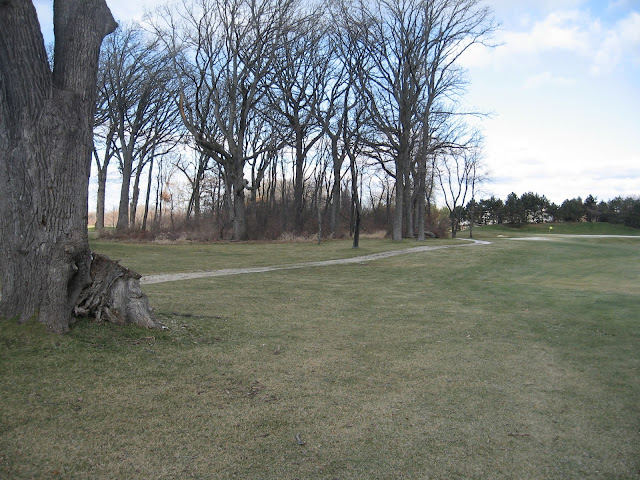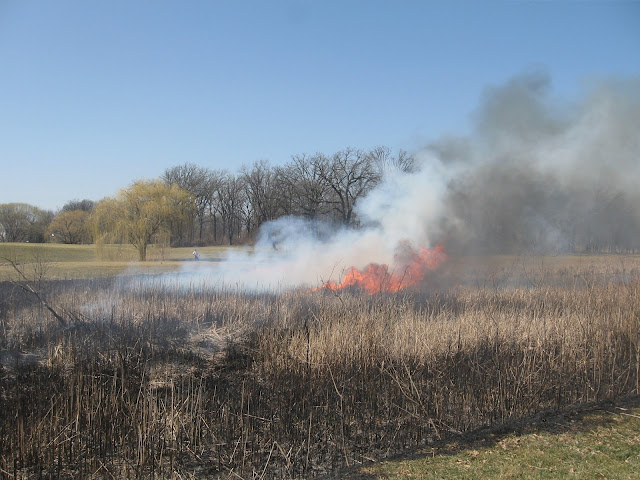Saturday, December 15, 2012
Wednesday, July 4, 2012
Dom Grotti Tournament
On June 19 Bernardo and I entered the Dom Grotti Tournament for superintendents and their assistants at Blackstone Golf Club. We came in second place and Bernardo won the closest to the hole proxy.
I guess I should mention that only three teams signed up, but we won't let that detract from the day.
Monday, June 25, 2012
Observed Soil Moisture Data
Observed soil moisture data are collected at 19 sites in Illinois by the Illinois State Water Survey’s Water and Atmospheric Monitoring program. The soil moisture is measured at 5 cm (2 inches), 10 cm (4 inches), 20 cm (8 inches), and 50 cm (20 inches). All amounts are reported as the fraction of water by volume of the soil. For example, a value of 0.35 means that 35% of the soil is occupied by water.
Silty clay loam soils, common in Illinois, are considered saturated at values of 0.45 to 0.50. Field capacity is in the neighborhood of 0.35. Values below about 0.20 would be at the permanent wilting point. As the name implies, that is the level where plants wilt and do not recover. Plant roots are unable to recover any water below this level because it is tightly bound to the soil particles.
See link to most recent soil moisture data: http://www.isws.illinois.edu/warm/soiltemp.asp
Sunday, June 24, 2012
Drought
Saturday, June 16, 2012
Water Shortage
The dry weather has been great for golf rounds but we are running out of water in our irrigation reservoir. This week we began transferring water from ponds on the golf course through the irrigation system backwards to the reservoir. Eventually we may need to buy water from the village, but if we can hold out, until the rain replenishes our supply, the water savings will be applied to better use.
Wednesday, March 14, 2012
Thursday, February 23, 2012
Opening Up The Left Side of 17 Tee
The left side of the 17th tee is very densely shaded with invasive buckthorn and honeysuckle underbrush. This tee has always struggled for lack of air circulation.
The nice warm winter days have allowed us to get in to this area and remove the invasive underbrush. This will create a more open feel for the golfers.
 |
| KEITH HAS RIGGED A STIHL WEEDEATER WITH BLADE ATTACHMENT |
It will also reduce lost balls from errant shots on the adjacent 16th hole.
 |
| Left side of 16 |
We have also cleared brush on the right side of the 16th hole. The back nine has a much more open feel to it now.
 |
| Right side of 16 |
I can't remember a winter with more opportunity to get work done outside!
Tuesday, January 31, 2012
Conservation Work Near 11 Tee
Keith and I have been working on clearing willow and buckthorn saplings that have grown up around the pond between 11 and 16.
 |
| Brad |
In the spring we will plant grass here and maintain the pond banks as turf grass. The turf grass will provide a much more effective filter for keeping silt and sediment erosion out of the pond than the sparse cover of reed canary grass that grows in the shade of the willow and buckthorn plants.
And now the golfers will be able to actually see the fairway landing area from the tee. Our championship flight golfers will even be able to draw the ball after we have finished the work.
 |
| Before Clearing of Right Side |
 |
| After Clearing the Right Side |
Whenever you present more options to the golfer from the tee you make the game more interesting and rewarding.
 |
| Opening Up View of 16th Hole |
Friday, January 6, 2012
The warm winter days have allowed us to spend most our time outdoors performing forestry and conservation work. We have now completed removal of invasive Buckthorn and Honeysuckle between holes 11 and 12. This spring we expect to see a proliferation of native wildflowers and ground cover.
Conservation of Illinois hardwood forests involves identifying the invasive species, getting after them with chainsaws and burning.
The pond between 11 and 12 has now been cleared of Willow and Cottonwood saplings that were compromising the ecosystem.
 |
| Before |
 |
| After |
 |
| Brad |
 |
| Rich & Keith |
The pond between 11 and 12 has now been cleared of Willow and Cottonwood saplings that were compromising the ecosystem.
When Willow and Cottonwood saplings are allowed to take over the embankments of a pond, the shade and root competition compromise the density of the turf grass buffer, now silt and sediment erosion enter the pond for lack of an adequate grass buffer and filter.
When the percentage of silt increases in surface water the invertebrate populations decrease to the detriment of the fish population. So we are working this winter to reestablish sunlight on our pond perimeters for a healthier turf system.
In addition to providing recreational benefits, turf grass protects surface water from silt and sediment erosion - the number one source of pollution in the world today.
Subscribe to:
Posts (Atom)









































